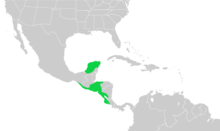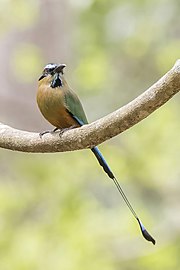Turquoise-browed motmot
| Turquoise-browed motmot | |
|---|---|
 | |
| E. s. apiaster, Honduras | |
| Scientific classification | |
| Domain: | Eukaryota |
| Kingdom: | Animalia |
| Phylum: | Chordata |
| Class: | Aves |
| Order: | Coraciiformes |
| Family: | Momotidae |
| Genus: | Eumomota P.L. Sclater, 1858 |
| Species: | E. superciliosa |
| Binomial name | |
| Eumomota superciliosa (Sandbach, 1837) | |
 | |
The turquoise-browed motmot (Eumomota superciliosa) is a colourful, medium-sized bird of the motmot family, Momotidae. It inhabits Central America from south-east Mexico (mostly the Yucatán Peninsula), to Costa Rica, where it is common and not considered threatened. It lives in fairly open habitats such as forest edge, gallery forest and scrubland. It is more conspicuous than other motmots, often perching in the open on wires and fences. From these perches it scans for prey, such as insects and small reptiles. White eggs (3–6) are laid in a long tunnel nest in an earth bank or sometimes in a quarry or fresh-water well. Its name originates from the turquoise color of its brow. It is the national bird of both El Salvador and Nicaragua, where it is known as torogoz and guardabarranco respectively.[2][3]

The bird is 34 cm (13 in) long and weighs 65 g (2.3 oz). It has a mostly grey-blue body with a rufous back and belly. There is a bright blue strip above the eye and a blue-bordered black patch on the throat. The flight feathers and upperside of the tail are blue. The tips of the tail feathers are shaped like rackets and the bare feather shafts are longer than in other motmots. Although it is often said that motmots pluck the barbs off their tail to create the racketed shape, this is not true; the barbs are weakly attached and fall off due to abrasion with substrates and with routine preening.[4]
Unlike most bird species, where only males express elaborate traits, the turquoise-browed motmot expresses the extraordinary racketed tail in both sexes. Research indicates that the tail has evolved to function differently for the sexes. Males apparently use their tail as a sexual signal, as males with longer tails have greater pairing success and reproductive success.[5] In addition to this function, the tail is used by both sexes in a wag-display, whereby the tail is moved back-and-forth in a pendulous fashion.[6] The wag-display is performed in a context unrelated to mating: both sexes perform the wag-display in the presence of a predator, and the display is thought to confer naturally selected benefits by communicating to the predator that it has been seen and that pursuit will not result in capture. This form of interspecific communication is referred to as a pursuit-deterrent signal.[7]
The call is nasal, croaking and far-carrying.
The turquoise-browed motmot is a well-known bird in its range. It has acquired a number of local names including guardabarranco ("ravine-guard") in Nicaragua, torogoz in El Salvador (based on its call) and pájaro reloj ("clock bird") in the Yucatán, based on its habit of wagging its tail like a pendulum. In Costa Rica it is known as momoto cejiceleste or the far-less flattering pájaro bobo ("foolish bird"), owing to its tendency to allow humans to come very near it without flying away.
References
[edit]- ^ BirdLife International (2020). "Eumomota superciliosa". IUCN Red List of Threatened Species. 2020: e.T22682992A163630124. doi:10.2305/IUCN.UK.2020-3.RLTS.T22682992A163630124.en. Retrieved 12 November 2021.
- ^ "Decreto Legislativo No 735 del 21 de octubre de 1999" (PDF). Diario Oficial (in Spanish). 345 (216). San Salvador: Imprenta Nacional de El Salvador: 6. 19 November 1999. Retrieved 22 July 2017.
- ^ "Ley No. 795 que declara al guardabarranco, ave nacional de Nicaragua". Diario Oficial (in Spanish) (118). Managua: La Gaceta. 25 June 2012. Retrieved 22 July 2017.
- ^ Murphy, Troy G. (2007). "Lack of melanized keratin and barbs that fall off: how the racketed tail of the turquoise-browed motmot Eumomota superciliosa is formed". Journal of Avian Biology. 38 (2). Nordic Society Oikos: 139–143. doi:10.1111/j.2007.0908-8857.04055.x.
- ^ Murphy, Troy G. (2007). "Racketed tail of the male and female turquoise-browed motmot: male but not female tail length correlates with pairing success, performance, and reproductive success". Behavioral Ecology and Sociobiology. 61 (6). Springer-Verlag: 911–918. doi:10.1007/s00265-006-0320-z. S2CID 8966707.
- ^ Murphy, Troy G. (2006). "Predator-elicited visual signal: why the turquoise-browed motmot wag-displays its racketed tail". Behavioral Ecology. 17 (4). International Society for Behavioral Ecology: 547–553. doi:10.1093/beheco/arj064.
- ^ Murphy, Troy G. (2007). "Dishonest 'preemptive' pursuit-deterrent signal? Why the turquoise-browed motmot wags its tail before feeding nestlings". Animal Behaviour. 73 (6). Springer-Verlag: 965–970. doi:10.1016/j.anbehav.2006.10.020. S2CID 6828682.
- Fogden, Susan C. L.; Fogden, Michael; Fogden, Patricia (2005). A Photographic Guide to Birds of Costa Rica. New Holland. ISBN 978-1-84330-960-4.
- Howell, Steve N. G.; Webb, Sophie (1995). A Guide to the Birds of Mexico and Northern Central America. Oxford University Press. ISBN 978-0-19-854012-0.
- Ridgely, Robert S.; Gwynne Jr., John A. (1989). A Guide to the Birds of Panama with Costa Rica, Nicaragua and Honduras. Princeton University Press. ISBN 978-0-691-02512-4.
External links
[edit]- Turquoise-browed Motmot research by Troy G. Murphy at Trinity University, Texas
- Stamps[usurped] (for El Salvador, Honduras, Mexico, Nicaragua, and Panama) at bird-stamps.org[usurped]
- Turquoise-browed motmot photo gallery at VIREO (Drexel University)
- "Turquoise-browed motmot media". Internet Bird Collection.
- Turquoise-browed motmot in Laguna de Apoyo Nature Reserve, Nicaragua
- Turquoise-browed motmot species account at Neotropical Birds (Cornell Lab of Ornithology)
- Interactive range map of Eumomota superciliosa at IUCN Red List


 French
French Deutsch
Deutsch











